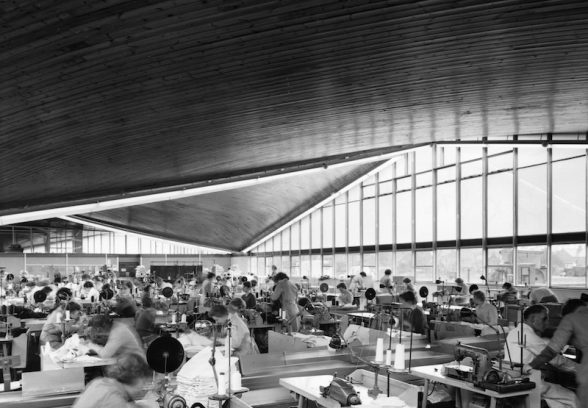This website uses cookies
This website uses cookies to enable it to function properly and to analyse how the website is used. Please click 'Close' to accept and continue using the website.



Silhouette Corset Factory, Market Drayton
Status: Destroyed
Type: Commercial/offices
Architect: Robert Townsend
Location: A529, Market Drayton, Shropshire TF9 3EF
The Silhouette Corset Factory was recognised from first construction as a pioneering example of laminated timber engineering’ and ‘a very unusual and ground-breaking structure. It was designed between 1959-60 by architect Robert Townsend and structural engineer Hugh Tottenham, with input by Ove Arup and Partners. The factory was commissioned by George Lobbenberg, who produced women’s underwear.
Designed with a clear space of 28,800 square feet, the building was specifically acclaimed for its four hyperbolic paraboloid laminated timber shell roofs which were held up by a central column and timber struts. The building’s unique roofs, with lights at the junctions of the shells, were best appreciated from the higher ground to the rear. From this perspective, they formed a double ‘M’ series resembling glazed gables in metal framing. The façade was brick clad with curtain walls at the upper levels and with corners that appeared unsupported. Additionally, the structure featured external reinforced concrete buttresses which supported two of its shell roofs and a concrete slab. In 1962 movement in the hyper (hyperbolic paraboloid structure) led to replacement of the roof by Ove Arup and partners, with the addition of tie beams as at Townsend and Tottenham’s earlier factory building at Wilton, Wiltshire. As the building’s listing noted, it combined “an exterior of careful quality with a roof of great technical innovation that is now unique for its size. Britain pioneered the use of timber for hyperbolic paraboloid construction, and Townsend and Tottenham’s two factories were the leaders in this experimentation”.
After the factory closed the building found productive use as a supermarket of the Somerfield chain, for which its open plan was ideally suited. When Somerfield closed, the building fell into disuse. Sadly when the LIDL supermarket conglomerate took over the site it decided to replace the building with a structure specified to its own superstore requirements. The Society and others campaigned to save the building and on 2 August 2000, the very day it was set to be demolished, the factory was listed at Grade II. Undeterred, LIDL persisted with its demolition plans, winning listed building consent from North Shropshire District Council. English Heritage opposed demolition and obtained a structural report from the original structural consultants, Ove Arup and Partners, demonstrating that the building was sound and capable of reuse. To the Society’s great disappointment the Secretary of State declined to call the application in for further examination, paving the way for demolition, which took place in 2002.
Source
McCaig, I and Ridout, B; Practical Building Conservation – Timber; London, English Heritage; 2012
This text needs adding

Become a C20 member today and help save our modern design heritage.